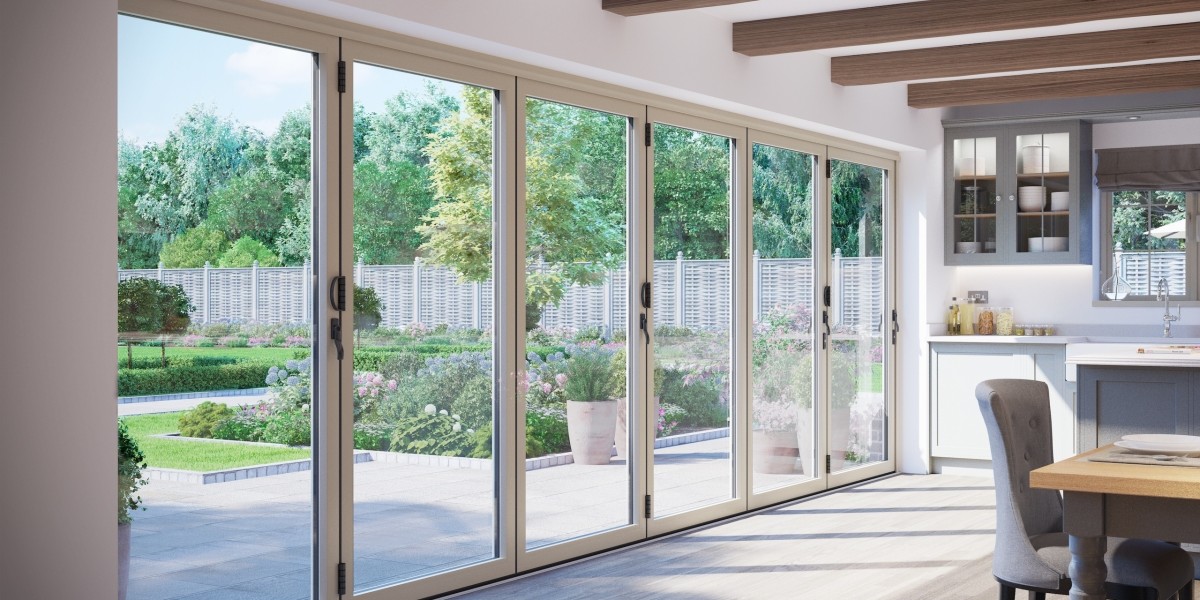Unfolding Solutions: A Guide to Bifold Door Repairs
bifold door trouble doors, with their concertina-like design, offer a fantastic blend of space-saving functionality and visual appeal. Whether beautifying a closet, dividing rooms, or opening outdoor patios to the outdoors, these doors bring a special touch to any area. Their ability to nicely fold away, taking full advantage of access and light, makes them a popular choice in contemporary homes and business settings alike. Nevertheless, like any moving component within a building, bifold doors are vulnerable to wear and tear over time. From minor inconveniences like sticking or squeaking to more significant issues like drooping or damaged panels, problems can occur that interrupt their smooth operation and interfere with their designated purpose.
Understanding typical bifold door problems and understanding how to address them is essential for maintaining their functionality and longevity. This short article aims to be your extensive guide to bifold door repairs. We'll check out the typical culprits behind bifold door malfunctions, delve into DIY repair possibilities, and talk about when it's best to call in the experts. By arming yourself with this understanding, you can guarantee your bifold doors continue to operate flawlessly and boost your living or working environment for many years to come.
Typical Bifold Door Problems: Identifying the Issues
Before you can embark on any repairs, it's vital to accurately diagnose the problem impacting your bifold doors. Acknowledging the symptoms and understanding their prospective causes will simplify the repair procedure and avoid unnecessary work. Here are some of the most often come across concerns with bifold doors:
Difficulty Opening or Closing: This is maybe the most typical grievance. The door might feel stiff, withstand motion, or get stuck at specific points along its track. This can frequently stem from several factors, consisting of:
- Dirty or Obstructed Tracks: Dust, debris, and even small objects can accumulate in the tracks, impeding the smooth slide of the rollers.
- Dry or Damaged Rollers: Rollers are essential for the uncomplicated motion of bifold doors. Absence of lubrication, wear and tear, or damage can trigger them to stick or grind.
- Misalignment: If the door panels or track are misaligned, the doors may bind and struggle to open or close properly.
- Obstructions within the Doorway: Sometimes, the problem isn't with the door itself however with something blocking its course, like a carpet that has moved or products placed too near to the opening.
Sagging Doors: Over time, bifold doors can start to sag, making them difficult to operate and potentially causing them to scrape along the flooring or frame. This sagging is often attributable to:
- Loose Hinges: Hinges are important for supporting the weight of the door panels. Loose hinges can lead to drooping and misalignment.
- Insufficient Support: If the door frame or track isn't supplying enough assistance, the weight of the doors can trigger them to droop.
- Door Weight: In some cases, the doors themselves may be too heavy for the hardware, particularly if they are strong core or made from much heavier materials.
Damaged Panels: Bifold door panels, particularly those made of thinner materials like hollow-core wood or MDF, can be vulnerable to damage:
- Cracks and Dents: Impacts or unintentional force can result in cracks or damages in the panels.
- Water Damage: In areas vulnerable to moisture, or in bathrooms, panels can warp or swell due to water ingress.
- Surface area Damage: Scratches, chips, or peeling veneer can interfere with the door's appearance.
Hardware Issues: The different hardware elements of troubleshooting bifold doors doors are vital for their function. Issues with these can cause functional difficulties:
- Loose or Broken Hinges: As pointed out, loose hinges contribute to sagging, and damaged hinges can render the door unusable.
- Faulty Handles or Latches: Broken deals with or latches can make it tough to open, close, or protect the doors.
- Harmed Pivot Points: The pivot points where the doors fold are crucial for smooth movement. Damage or wear here can trigger tightness and sticking.
Track Problems: The track is the foundation upon which the bifold doors run. Concerns here will straight affect door function:
- Bent or Damaged Track: Accidental impacts or settling of the building can flex or damage the track, impeding roller movement.
- Misaligned Track: If the track is not properly installed or has actually moved, the doors will not run efficiently.
Spaces and Draughts: Bifold doors are developed to close fairly comfortably. Gaps or draughts show a problem:
- Misalignment: Misaligned panels might not fulfill correctly, developing gaps.
- Worn Weather Stripping: Weather removing around the door border assists seal gaps. If harmed or used, it will stop working to provide a proper seal, causing draughts and possibly increased sound.
Noise Issues: Bifold doors need to run reasonably silently. Squeaking, grinding, or rattling noises suggest friction or loose elements:
- Dry Rollers or Hinges: Lack of lubrication in rollers or hinges frequently causes squeaking or grinding sounds.
- Loose Hardware: Loose screws or other hardware can trigger rattling sounds when the doors are moved.
DIY vs. Professional Repair: Choosing the Right Approach
As soon as you've diagnosed the issue, the next action is to choose whether you can take on the repair yourself or if it's finest to contact an expert. The decision frequently depends upon numerous aspects:
DIY Repairs - Pros and Cons:
Pros:
- Cost-Effective: DIY repairs can conserve you cash on labor expenses, typically needing just the expense of replacement parts or standard tools you may already own.
- Benefit: You can often resolve minor repairs at your own speed and schedule, without awaiting a professional visit.
- Learning Experience: DIY repairs can be a valuable knowing experience and provide you a greater understanding of how your bifold doors operate.
Cons:
- Time Commitment: DIY repairs can be time-consuming, particularly if you are unfamiliar with the procedure.
- Possible for Mistakes: Incorrect repairs can worsen the problem or perhaps harm the doors even more, potentially leading to more expensive expert intervention later on.
- Tool Requirements: Certain repairs may need specialized tools that you may not have.
- Safety Concerns: Repairs including ladders, heavy doors, or power tools can position security dangers if not handled correctly.
Professional Repairs - Pros and Cons:
Pros:
- Expertise and Experience: Professionals have the understanding and experience to precisely identify and efficiently repair a vast array of bifold door problems.
- Effectiveness: Professionals can usually finish repairs quickly and efficiently, decreasing disruption.
- Guarantees and Warranties: Reputable experts frequently provide warranties or warranties on their work, offering peace of mind.
- Specialized Tools and Parts: Professionals have access to specialized tools and a larger range of replacement parts if required.
Cons:
- Higher Cost: Professional repairs will inevitably be more costly due to labor expenses and possible call-out costs.
- Scheduling Inconvenience: You may require to set up a consultation and wait on an expert to appear.
When to DIY vs. When to Call a Pro:
DIY Suitable For:
- Simple tasks like cleaning up tracks and rollers.
- Lubing hinges and rollers.
- Tightening loose screws.
- Replacing easily available and basic hardware parts (rollers, handles).
- Small cosmetic repairs like touching up paint or filling little damages.
Professional Recommended For:
- Complex issues like door or track misalignment that require precise modifications.
- Drooping door concerns that might include structural assistance or hinge replacements.
- Replacement of whole panels or doors, specifically if they are bespoke or require exact fitting.
- Repairs involving damage to the frame or structural parts.
- Any repair that feels beyond your skill level or comfort zone, particularly those involving security issues.
Step-by-Step Repair Guides for Common Issues
While some repairs need professional proficiency, many common bifold door problems can be attended to with a little DIY knowledge. Here are step-by-step guides for taking on some of the most regular issues:
1. Dealing With Sticking or Difficult Opening/Closing:
* ** Step 1: Inspect and Clean the Tracks. **.* Use a vacuum cleaner with a crevice tool or a brush to completely clean the leading and bottom tracks of any dust, particles, or blockages.* ** Step 2: Lubricate Rollers and Tracks. **.* Apply a silicone-based lube to the rollers and along the tracks. Avoid oil-based lubricants, as they can attract dust.* Operate the doors numerous times to disperse the lubricant uniformly.* ** Step 3: Inspect Rollers for Damage. **.* Visually check each roller for fractures, chips, or excessive wear.* If rollers are harmed, they will need to be replaced (see hardware replacement area below).* ** Step 4: Check for Obstructions. **.* Ensure absolutely nothing is physically blocking the door's course, inside or outside the doorway.2. Replacing Worn or Damaged Rollers:
* ** Step 1: Identify Roller Type and Size. **.* Carefully get rid of a sample roller to figure out the type (e.g., top-hung, bottom-roller) and its measurements.* ** Step 2: Purchase Replacement Rollers. **.* Visit a hardware store or online provider to purchase coordinating replacement rollers.* ** Step 3: Remove Old Rollers. **.* Depending on the design, you might require to loosen or unclip the old rollers. Describe your door's setup guidelines if readily available.* ** Step 4: Install New Rollers. **.* Carefully insert and protect the brand-new rollers in location, guaranteeing they are appropriately lined up and move easily.* ** Step 5: Test Door Operation. **.* Gently run the doors to check if the brand-new rollers have actually dealt with the sticking issue. Lube as required.3. Tightening Loose Hinges:
* ** Step 1: Identify Loose Hinges. **.* Visually check all hinges linking the door panels for looseness or movement.* ** Step 2: Tighten Screws. **.* Use a screwdriver of the right size to carefully tighten any loose screws on the hinges.* Avoid over-tightening, which can strip the screw holes.* ** Step 3: Consider Longer Screws (if needed). **.* If screws continuously loosen, it might be necessary to replace them with slightly longer screws to get a much better grip in the door frame or panel.* ** Step 4: Test Door Operation. **.* Check if tightening the hinges has enhanced door positioning and lowered drooping.Preventive Maintenance: Keeping Your Bifold Doors in Top Shape
Routine upkeep is essential to preventing many bifold door concerns and extending their life expectancy. Integrating these simple maintenance practices can conserve you time and money in the long run:
- Regular Cleaning: Clean the tracks and door panels routinely (a minimum of regular monthly, or more often in dirty environments) to prevent debris accumulation.
- Lubrication: Lubricate rollers and hinges with silicone lube every couple of months to guarantee smooth and peaceful operation.
- Hardware Checks: Periodically inspect all screws and hardware elements for tightness and tighten up as required.
- Visual Inspections: Regularly check doors for indications of damage, wear, or misalignment. Address minor issues quickly before they escalate.
- Gentle Operation: Avoid slamming or requiring the doors, as this can harm hardware and lead to misalignment.
Cost Considerations for Bifold Door Repair
The expense of bifold door repair can differ widely depending on the nature of the problem, whether you DIY or employ an expert, and the cost of parts.
Do It Yourself Repair Costs:
- Primarily material costs, including:
- Replacement rollers, hinges, manages: Prices range from a few dollars for specific components to sets costing ₤ 20- ₤ 50 or more.
- Lube, cleaning up products: Relatively economical.
- Tools (if you need to purchase any): Basic screwdrivers are inexpensive; specialized tools may contribute to the expense.
Professional Repair Costs:
- Include labor costs in addition to parts.
- Hourly rates for handymen or door repair specialists can range from ₤ 50 to ₤ 100 or more, depending upon place and intricacy.
- Call-out charges might apply.
- More complicated repairs (e.g., panel replacement, substantial realignment) will naturally be more costly.
Factors Influencing Repair Costs:
- Complexity of the Problem: Simple fixes like cleaning and lubrication will be the least pricey. Significant repairs or replacements will be more pricey.
- Do it yourself vs. Professional: DIY is nearly always more affordable for fundamental repairs.
- Parts and Materials: The cost of replacement parts will vary depending upon the type and quality.
- Area: Labor costs can change based upon your geographical place.
- Emergency Repairs: Emergency or after-hours repairs may incur added fees.
Bifold doors are an important asset to any home, providing performance and design. By understanding common problems, knowing when to DIY and when to look for professional aid, and practicing routine maintenance, you can keep your bifold door maintenance doors operating smoothly and looking their best for several years to come. Attending to minor problems without delay is always much better than overlooking them up until they become major, more costly headaches. Put in the time to comprehend your bifold doors, and they will continue to unfold benefit and appeal in your space.
FAQs: Bifold Door Repair
Q: How do I know if I can DIY a bifold door repair or if I require to call a professional?
A: Start by evaluating the issue. If it's an easy problem like sticking doors that might be solved with cleansing and lubrication, or replacing a noticeable and quickly accessible roller or handle, DIY may be ideal. If the problem is structural, involves misalignment, panel replacement, or anything that feels beyond your ability level, it's definitely best to call a professional. Consider your comfort level with DIY tasks and focus on safety.
Q: How much does bifold door refurbishers door repair generally cost?
A: DIY repairs can cost as low as a few dollars for lube or replacement rollers. Professional repairs can range from ₤ 50 to numerous hundred dollars depending on the intricacy of the issue, labor rates, and parts needed. Get quotes from numerous specialists for bigger repairs to compare costs.
Q: What tools are usually needed for basic bifold door repairs?
A: For the majority of fundamental repairs, you'll need:
- Screwdrivers (Phillips and flathead in different sizes)
- Vacuum cleaner with crevice tool
- Brush or tooth brush (for cleaning tracks)
- Silicone-based lubricant
- Possibly pliers or wrenches, depending on hardware.
- Shatterproof glass and gloves are constantly advised.
Q: How often should I oil my bifold doors?
A: It's normally recommended to lube rollers and hinges every 3-6 months, or more frequently if you discover any squeaking, sticking, or stiffness in operation.

Q: Can I replace a bifold door panel myself?
A: Replacing a single bifold door panel can be intricate, specifically if it needs exact matching of size, style, and hardware. It may be DIY-able if you are comfortable with woodworking and have the needed tools and skills. Nevertheless, it's typically recommended to look for expert aid for panel replacements, particularly if the doors are customized or require precise fitting within the track system. Experts can likewise ensure proper alignment and prevent more issues after panel replacement.







